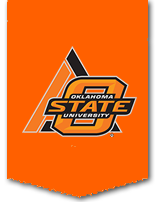FAPC Research Symposium highlights agricultural research
By Allison Richard
STILLWATER, Okla. – The Food & Agricultural Products Center hosted its 3rd Research Symposium recently. The symposium highlighted food and agricultural products research conducted by FAPC and other Oklahoma State University researchers.
Peter Muriana, FAPC food microbiologist and chair of the symposium, said the event included six oral presentations and 30 poster presentations.
"The event was a semi-formal gathering of those involved with food and agricultural products research," Muriana said. "The event provided an opportunity for graduate students and staff to make presentations of their work, to familiarize others in this field at OSU with what is being done in other labs and possibly foster future collaborations among colleagues."
Some of the topics of the oral and poster presentations included design of a watermelon pulp fruit and juice extraction machine, non-destructive methods for predicting beef tenderness, case study of selected economic impacts of services provided by the FAPC, reduction of Listeria monocytogenes on ready-to-eat meats using liquid smoke extracts and mineral extracts from peanut and pecan shell material for traditional soap making.
A special feature of this year's Research Symposium was a presentation by keynote speaker Juergen Richt, a veterinary medical officer with the National Animal Disease Center. NADC is an arm of the Agricultural Research Service and is the major USDA center for research on livestock and poultry diseases.
Richt spoke about animal prion diseases in the United States. He said prions or transmissible spongiform encephalopathies, or TSEs, are slow, fatal diseases that occur in a variety of mammals including humans. The incubation period of TSEs range from months to decades.
Richt said infection can occur from ingestion or parental inoculation. No effective pre/post clinical treatment is available, and the exact nature of the infectious agents is unknown. Diagnoses of TSEs are made post-mortem by locating the abnormal prion protein.
The different types of TSEs in animals include scrapie in sheep and goats, bovine spongiform encephalopathy in cattle, feline spongiform encephalopathy in domestic and wild cats, chronic wasting disease in deer and elk, and transmissible mink encephalitis in mink.
"After the BSE epidemic in the United Kingdom, surveillance of BSE in the United States has increased," Richt said. "The surveillance includes cattle with CNS signs, rabies suspects, and cattle that are nonambulatory or known as 'downers.'"
Richt said from 1994 to 2001 the U.S. Department of Agriculture had examined 21,451 cattle. In 2002 alone, 20,543 cattle were tested.
Unfortunatley, on Dec. 23, 2003, the U.S. Department of Agricultural announced that BSE was found in a dairy cow in Washington State. Because of this, the number of tests performed per year will likely increase.
"Before Dec. 23, 2003, all the cattle tested were negative,” Richt said. "The BSE scare created a great threat to the safety of the food supply."
Richt went on to describe how the United States handled the BSE episode. Because of the increased surveillance and immediate action from Richt and other individuals, the dairy cow infected with BSE did not enter into the food supply.
Muriana said the FAPC was lucky to have Richt speak during the Research Symposium, and his presentation was extremely beneficial to those who attended the symposium.
"The occurrence of BSE in the USA would have far reaching consequences in regard to cattle, the meat industry and cattle-derived by-products," Muriana said. "We were glad to have Dr. Richt provide an update on BSE and his current research in this area that is of vital importance to a main economic commodity of Oklahoma."
- ### -
Oklahoma State University, U.S. Department of Agriculture, State and Local Governments Cooperating. The Oklahoma Cooperative Extension Service offers its programs to all eligible persons regardless of race, color, national origin, religion, sex, age, disability, or status as a veteran, and is an equal opportunity employer.

